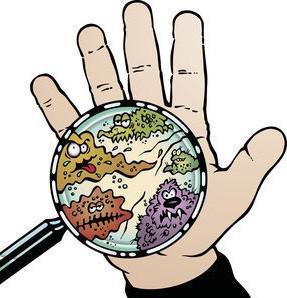 Hand washing: An easy way to prevent infection
Hand washing: An easy way to prevent infection
Hand washing is a simple habit, something most people do without thinking. Yet hand washing, when done properly, is one of the best ways to avoid colds, flu, poisoning, and diarrhea. This simple habit requires only soap and clean water or an alcohol-based hand sanitizer — a cleanser that doesn’t require water.
The dangers of not washing your hands
Despite the proven health benefits of hand washing, many people don’t practice this habit as often as they should — even after using the toilet. They go to the toilet, pick up like a million germs and then go shaking everyone and even picking their teeth.
Throughout the day you accumulate germs on your hands from a variety of sources, such as direct contact with people (who don’t wash their own hands!), contaminated surfaces, foods, even bingo (or is it Bruno) the beloved family pet and his feaces. If you don’t wash your hands frequently enough, you can infect yourself with these germs by touching your eyes, nose or mouth. And you can spread these germs to others by touching them or by touching surfaces that they also touch, such as doorknobs or water faucets.
Infectious diseases that are commonly spread through hand-to-hand contact include the common cold, flu and several gastrointestinal disorders, such as infectious diarrhea. While most people will get over a cold, the flu (remember Bird Flu?) can be much more serious. Some people with the flu, particularly older adults and people with chronic medical problems, can develop pneumonia. The combination of the flu and pneumonia, in fact, is the eighth-leading cause of death among Americans.
Inadequate hand hygiene also contributes to food-related illnesses, such as salmonella (commonly known as typhoid) and E. coli (a bacterial) infection. According to the Centers for Disease Control and Prevention (CDC) in America (am sorry I don’t have the statistics for Nigeria), as many as 76 million Americans get a food-borne illness each year. Of these, about 5,000 die as a result of their illness.
So hand washing is a lifesaver!
Proper hand-washing techniques
Okay! I should wash my hands. So after doing “the major job”, you get a bowl of water stationed in your toilet, dip your hands into it and then smile to yourself. Good? No, wrong! In order to benefit from hand washings you must do it properly. Good hand-washing techniques include washing your hands with soap and water or using an alcohol-based hand sanitizer. Antimicrobial wipes or towelettes are just as effective as soap and water in cleaning your hands but aren’t as good as alcohol-based sanitizers.
Antibacterial soaps have become increasingly popular in recent years. However, these soaps are no more effective at killing germs than is regular soap. As I write this, the several adverts that claim this and are regularly shown on television stations come to my mind. Please never mind them. Evidence shows that routine use of antibacterial i.e. medicated soaps may lead to the development of bacteria that are resistant to the products’ antimicrobial agents — making it even harder to kill these germs in the future! In general, regular soap is fine. The combination of scrubbing your hands with soap — antibacterial or not — and rinsing them with water loosens and removes bacteria from your hands.
Proper hand washing with soap and water
Outlined below is the proper way to wash you hands with soap and water:
- Wet your hands with warm, running water (or get someone to pour it for you) and apply liquid soap or use clean bar soap. Lather them well.
- Rub your hands vigorously together for at least 15 to 20 seconds.
- Scrub all surfaces, including the backs of your hands, wrists, between your fingers and under your fingernails.
- Rinse well.
- Dry your hands with a clean or disposable towel.
- Use a towel to turn off the faucet.
When should you wash your hands?
Although it’s impossible to keep your bare hands germ-free, there are times when it’s critical to wash your hands to limit the transfer of bacteria, viruses and other microbes.
Always wash your hands:
- After using the toilet
- After changing a diaper — wash the diaper-wearer’s hands, too
- After touching animals or animal waste
- Before and after preparing food, especially before and immediately after handling raw meat, poultry or fish
- Before eating
- After blowing your nose
- After coughing or sneezing into your hands
- Before and after treating wounds or cuts
- Before and after touching a sick or injured person
- After handling garbage
- Before inserting or removing contact lenses
- When using public restrooms, such as those in airports, train stations, bus stations and restaurants
What are some mistakes you should avoid regarding hand washing?
- DON’T use a single damp cloth to wash a group of children’s hands.
- DON’T use a standing basin of water to rinse hands.
- DON’T use a common hand towel. Always use disposable towels in day care or food preparation and serving settings (eg that canteen you go to every afternoon)
- DON’T use sponges or non-disposable cleaning cloths. Germs thrive on moist surfaces.
« I confirm the subscription of this blog to the Paperblog service under the username mangee »

